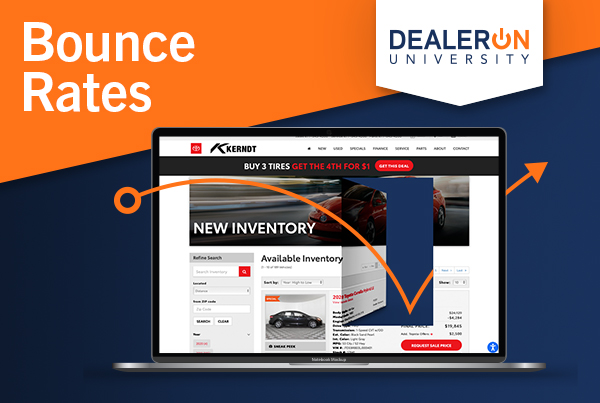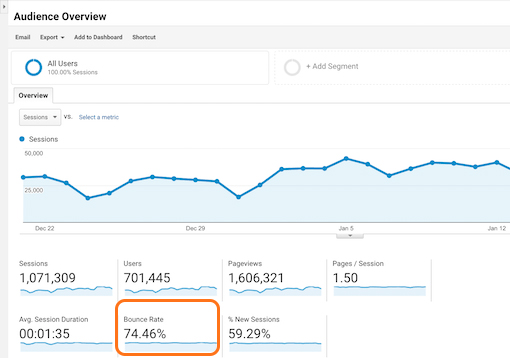

Bounce rate remains one of the most popular web analytics. It’s easy to see why. Measuring how many visitors access a single page on a site before leaving, is a simple, at-a-glance metric of how engaged one’s users are. But numbers without context can be misleading, or even damaging.
What’s a good Bounce Rate?
Let’s say you’re looking at analytics for your site and find that your bounce rate is 65%. Is that good or bad? At a glance, you might decide it’s bad, as it’s over half your visitors landing on your site and immediately bouncing away.
 Bounce Rates can be found under Audience Overview in Google Analytics
Bounce Rates can be found under Audience Overview in Google Analytics
Andy Crestodina over at OrbitMedia decided to crunch the numbers. Using data from 501 websites, he determined that the average bounce rate is 61% and for e-commerce sites (the closest analogue to a dealer’s site that he tested) was 62%. With that additional context, you know that a bounce rate of 65% is bad, but not end-of-the-world bad. It’s also hypothetical, so don’t panic.
A 60% Bounce Rate seems high.
It does, doesn’t it? The best way to contextualize it is by looking at your own web browsing habits. Bounce rates can include a user checking back on a previously visited page, or a bored person on social media impulsively clicking on a link, or even a repeat visitor checking on a fact or figure. It could be an open browser tag that sits there for days, or a site that takes a long time to load. The point is, a majority of traffic is just a user poking their head into the metaphorical room.
“…you know that a bounce rate of 65% is bad, but not end-of-the-world bad.”
Bounce rates also vary by the kind of traffic. Organic traffic has the lowest bounce rate at 55.6%, while referrals have the highest at 76.8%. Simply thinking about the circumstances for those kinds of hits helps explain that behavior. Organic traffic got to you with intent. The only figure that seemed high to Crestodina was 62.6% for paid search traffic. If you run analytics and your paid search is bouncing at this rate, either look into your advertising or stop paying for that service. Actually, do both.
What are good ways to reduce Bounce Rate?
Reducing your bounce rate is all about getting visitors to stick around. You need to ensure that your site is loading properly and quickly. Three seconds is more of a benchmark than a law, but make sure your page is around that magic number. Your site should be attractive and professional, with no images or videos that fail to load. And if your site plays music, get it to stop. No one likes that.
You want to attract visitors who are in the mood to shop for cars, or at least peruse inventory. Maybe profiling a specific special or new vehicle will entice more viewers to look deeper into the site. Remember, your goal isn’t avoiding bounces as much as it is converting a lead. Stopping a bounce is only step one.
It’s important to keep in mind that having over half your traffic bounce is not anything to worry about. Bounce rate is not the most important metric. It’s a useful tool, but should not govern your outlook.


